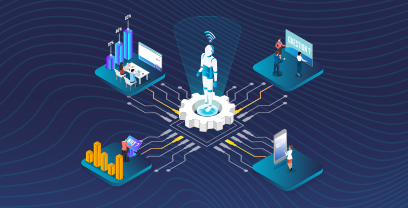Blog »
5 Steps Towards Modernizing Supplier Management

by Alex Saric
When it comes to the nature of buyer-supplier relationships, we’re entering a brave, new world. Organizations are increasingly dependent on suppliers to successfully bring innovative goods and services to market on time, improve ESG performance, and meet other objectives. Even reducing costs often depends more on effective collaboration rather than negotiation in today’s market. At the same time, organizations have never been more exposed to risk from their supply chains, from supply continuity, quality, or ESG violations. Governments, employees, and customers hold businesses accountable for scope 3 emissions, forced labor, and sanctions violations. To top it all off, extremely tight supply markets have further shifted negotiating leverage from buyers to suppliers.
Effectively managing suppliers is now one of the most important factors in organizational success. Yet, too few businesses do so well. Limited communication, poor visibility, and transactional relationships are still the norm with the bulk of suppliers. In fact, a recent study from Forrester Consulting commissioned by Ivalua identified only 13% of businesses as leaders when it comes to supplier management, defined by Forrester as having formal programs that are broadly applied across the supply base.
Business leaders must adopt a new, holistic approach to supplier management. The Forrester study identified consistent obstacles, as well as clear strategies to successfully manage suppliers to achieve a range of strategic objectives and is well worth a read. Below, we outline the 5 steps toward modernizing supplier management, addressing both transparency and effective engagement.
1. Gain control of your supplier data. Few organizations know which suppliers they buy from and just how much. Data remains dispersed among multiple systems, with duplicates and errors common. Spend analysis solutions can help rationalize supplier data and provided an accurate snapshot, but are insufficient. By default they work after the fact, and rarely do they fix the underlying issues in back end systems. To truly gain control of enterprise-wide supplier data, leaders must implement vendor master data management (MDM). Such solutions, especially if embedded in spend management suites, can help unify data across the enterprise and fix duplicates and other issues at the source. Chassis Brakes Int’l (now part of Hitachi), presents a great example, having unified supplier data across all 25 global ERP environments through it’s global Source-to-Pay (S2P) platform. The permanent transparency helped drive a rationalization of its supply base to improve performance, relationships and deliver savings and lower risk.
Successfully employing MDM requires procurement to closely engage IT. Unfortunately, collaboration with IT was identified as the top obstacle to improved supplier visibility. Leaders must make a concerted effort.
2. Enable 360-degree visibility. Once you know who your suppliers are, you must enable visibility into all relevant aspects, whether they are risk, performance, or ESG policies. This applies both to new suppliers you are considering selecting as well as monitoring of existing suppliers. Fragmented S2P applications are the top challenge here. Ironically, Forrester found that this problem is most acute for organizations that are most advanced with supplier management. Too many of these enthusiastically adopted best-of-breed, point technology solutions to solve immediate issues, finding that they exacerbated the problem of data fragmentation. Leaders must plan out the long-term data approach when selecting technology.
While no solutions provide all information required, a hub and spoke model, with a core, modular platform that unifies enterprise-wide data to a single record per supplier and integrates seamlessly through a robust ecosystem of additional sources (i.e. financial data, ESG scores…), provides the requisite visibility. The key is to look under the covers of the many so-called “integrated suites” or “platforms” to understand if data is unified within S2P and how easily it can be complemented by external sources.
3. Map your Sub–tier. The breadth of 360-degree visibility into your immediate suppliers must be complemented with depth. Most supply risks, whether from disruptions or ethical violations, lurk not among immediate suppliers, but in the sub-tier. Yet visibility is broadly woeful, leaving organizations exposed and blind. Unsurprisingly, this was the 3rd greatest obstacle identified by Forrester. Effective risk management or improvement plans must include sub-tier suppliers.
S2P technology should be leveraged to address this problem. The key is providing suppliers direct access to the system and defining action plans for them to enter sub-tier dependencies. Inputting this information directly into the system drives efficiency – no need to manually consolidate emails or spreadsheets. It also allows users to automatically enrich sub-tier suppliers with risk and performance data from external or internal sources, and map common dependencies across suppliers to better assess risk.
4. Enable effective, scalable collaboration. Effective supplier management is not just about selecting the right suppliers and monitoring them. That should provide an initial boost in results, but the biggest gains often come from ongoing engagement. Take carbon reductions for example. Almost no organization is where it wants to be. With 70% of emissions coming from the supply chain, the key to meeting the aggressive targets being announced by ever more companies is to collaborate with suppliers that are as keen to improve as you are. Unlocking supplier-led innovation (the top opportunity identified by respondents to Forrester’s study) also depends on collaboration.
As with transparency, the key to maximizing value here is to enable broad and deep collaboration. Collaboration should span the full supplier lifecycle, from new product introduction planning, to forecasts and planned orders, to payments. Depth requires more than simply transactional details, but also secure sharing of product specifications, joint collaboration on action or improvement plans, and more.
Digitizing collaboration is the key to success. It is critical to the top 3 planned strategies going forward, from collaborating with more suppliers to increasing flexibility in how suppliers. meet requirements and share more information. A lack of technology to enable supplier collaboration was identified as the top obstacle to improving sustainability and top 3 for improving innovation.
Leaders should ensure that collaboration supports this required depth and breadth. That means spanning the S2P process, allowing secure sharing of a variety of information, supporting project management and automating action or improvement plans. Automotive parts leader Meritor presents a great example, having digitized the full supplier and product lifecycle to improve collaboration and accelerate the launch of new products.
5. Incentivize the right behavior. Last but not least, let us not forget the critical human aspect. The above steps will only drive the intended result if procurement AND suppliers are incentivized to collaborate. Procurement needs skin in the game. That means procurement KPIs must reward improved benefits achieved from improved supplier management, whether that is improved sustainability, less disruptions or other. Cost dominated KPIs incentivize the old way of working with suppliers.
Similarly, suppliers need to be incentivized if you expect them to share innovations or invest more time than needed to simply fulfil orders. That is true even for the largest organizations. Implement a customer of choice program, or assess and improve an existing one. Pay suppliers on time, give them more flexibility in how they meet your requirements, be transparent with them, and give them access to the systems they need to more easily and effectively collaborate with you.
Naturally, each of these steps warrant more detail – in some cases an entire book’s worth. But by thinking through each and building out the right approach to holistically managing your suppliers given your priorities and constraints, you will be well ahead of your peers. So don’t delay. Get on the path to unlocking the true potential of your supply base.
For more details, download the New Forrester Study here.

Alex Saric
Chief Marketing Officer
Alex has spent over 15 years of his career evangelizing Spend Management, shaping its evolution and working closely with hundreds of customers to support their Digital Transformation journeys. As CMO at Ivalua, Alex leads overall marketing strategy and thought leadership programs. Alex also spent 12 years at Ariba, first building and running the spend analytics business as General Manager. He then built and led Ariba’s international marketing team until successful acquisition by SAP, transitioning to lead business network marketing globally. Earlier, Alex was a founding member of Zeborg (acquired by Emptoris)where he developed vertical Procurement applications. He began his career in the U.S. Cavalry, leading tank and scout platoons through 2 combat deployments. Alex holds a B.S. in Economics from the U.S. Military Academy at West Point and an international M.B.A. from INSEAD.
You can connect with Alex on Linkedin




